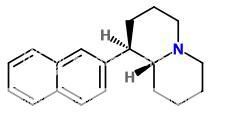A few words on the topic of dimerisation:
First, I think Sollipsis meant to post the following image (he posted the pyrazine derivative instead of the dihydropyrazine one).
As another example, here is the following dimerisation of cathinone:
Imine formation is reversible and also requires acid or base catalyst to reach equilibrium fast. If it is stored in neutrality, or in an excess of water, I don't think dimerization would be a problem. The problem is when the compound reaches the stomach, and its acidic conditions. As Sollipsis said, this can be circumvented by dosing on an empty stomach. Even better, administering it via rectal, nasal or intravenous routes would do the job. Once in the blood (neutral pH of around 7.4), dimerisation will reach equilibrium very slowly.
Even with this, I still don't think dimerisation should pose that much of a problem; in the stomach there is still quite a large excess of water in comparison to the concentration of the drug so even if equilibrium is fully reached, the concentration of the dimerized compound should be low. Also it wouldn't be entropically favourable.
Furthermore, if this was a problem then even secondary beta ketone amines (like methcathinone, methylone, mephedrone, bupropion even) would face this problem, only to form the enamine derivative instead. To illustrate:
Methcathinone dimerisation:
Meph dimerisation:
M1 dimerisation:
On a final note, take a look at this link:
http://www.rxlist.com/wellbutrin-xl-drug/clinical-pharmacology.htm
"Absorption
Following single oral administration of WELLBUTRIN XL tablets to healthy volunteers, the median time to peak plasma concentrations for bupropion was approximately 5 hours. The presence of food did not affect the peak concentration or area under the curve of bupropion."
This would be dimerised Wellbutrin in the stomach supposedly:
Having said this, there is evidence to suggest dimerisation (of secondary amines at least, and likely primary amines) does not take place to a significant extent in the acidic environment of the stomach, probably because water is in excess. But then again, in bupropion there might be slightly more steric hindrance preventing enamine dimerisation.
I guess the only way of really testing all these hypotheses is leaving a beta keto phenethylamine in acidic aqueous solution for a while and measuring the equilibrium concentration of the original and dimerised compounds. If a significant amount of dimerised compound concentration is observed, then measure the rate at which it is formed in acidic conditions. If the rate is fast, then I guess another route of administration avoiding the stomach must be sought.
Sadly for me it'll be at least 5 years before I'll ever even have a possibility using a LCMS and NMR...
EDIT: Having thought about this, I'm now tending to think that primary bk-amines could actually dimerize (reversible) but then oxidize to aromatic pyrazines (irreversible) as DotChem mentioned. This would be less likely with secondary bk-amines because the 2 nitrogens would both have to form salts.





























